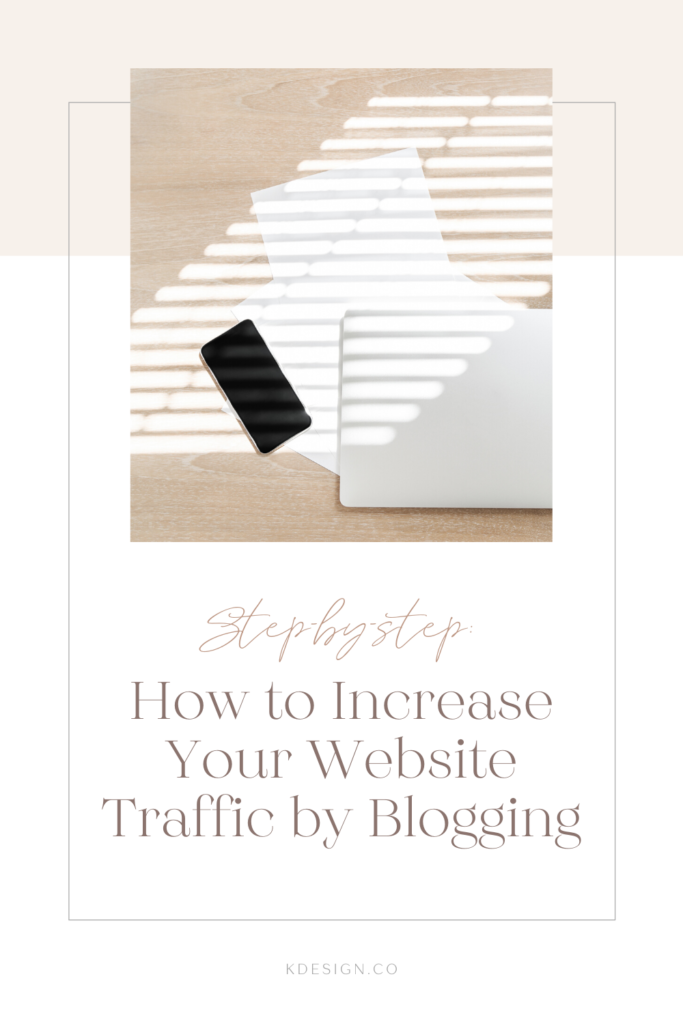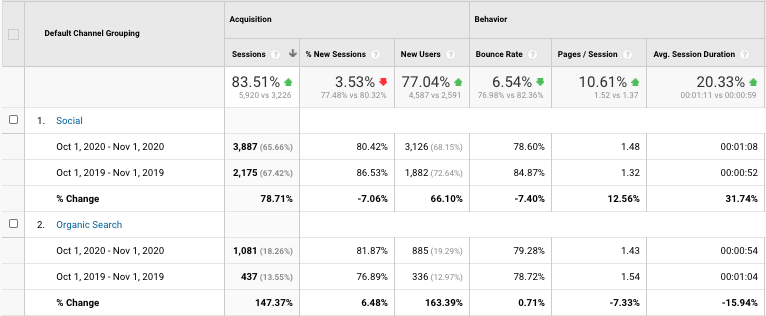When I started my website back in 2014, I was excited if I got 10 visitors a week. I obsessed over my analytics and wondered what was the point of it all. Maybe this is where you are too, but don’t get down on yourself, because we all have to start somewhere!
Now, I generate thousands of visitors to my site each day and in this post, I’m telling you exactly how I made it happen. It all started with blogging.
Related Post: How to Blog for Your Business and Why You Should Start

If you love to write, blogging on your website can be a great way to drive an insane amount of organic traffic. I know this because I’ve seen the effects firsthand.
Personally, I love blogging, and putting my thoughts on “paper” is cathartic for me. I can take all those ideas that have been bouncing around in my head and finally get them out of my brain.
The best part is that I can use those ideas to help my clients and they are also an amazing source of traffic for my website. But writing for the sake of writing, won’t generate the kind of traffic that makes an impact. You need to approach blogging with a strategy if you want your writing efforts to pay off. And that’s just a fancy way of saying you need to have a plan for what you are writing about.
So, how do you get started with blogging to increase traffic to your website? Here’s what I suggest.
1. Acknowledge that your blog isn’t for you. It’s for your customers/clients.
This is the most important step. If your blog is only self-serving, you are going to have a really hard time generating significant search traffic from it. Hate to break it to you, but unless you’re a celebrity, influencer, or well-known brand, complete strangers really aren’t interested in you or your life 🙁
What people are interested in is how you can help them with their problems and pain points. That doesn’t mean your blog can’t have a healthy dose of your personality and personal stories mixed-in, but at its core, you need to use your blog as a tool to answer questions, inspire solutions and focus on challenges that your clients or customers have.
If you want to have a blog that you use as a personal journal to record a play-by-play of your every thought, random interests, and what you ate for dinner last night, you can totally do that. Just don’t expect a lot of traffic from it besides friends or family members.
2. Create a Content Calendar
A content calendar will keep your blogging efforts organized and structured which is the best way to approach writing if you are doing it to drive any sort of outcome. There are a number of ways you could create your content calendar, but here’s what I do as an example for inspiration:

- At the beginning of the year, I create a Google sheet with a separate tab for each month.
- For each month, I decide on a content theme I want to make my focus. Usually, these themes align or closely relate to specific services or products I offer to my clients (ie. brand design, website design, etc.) but a few might be more seasonal or client-related (ie. in April this year, I focused on finances, and in December I will focus on Customer Service and Client Gifts)
- Then each quarter, I brainstorm blog topic ideas for the months related to the theme I picked. I like to blog once a week so I try to think of at least 4-5 topics that I want to write about related to that theme. I enter each idea on its own line. At this point, you don’t have to have the full blog title nailed down, but do commit to a rough idea of what you want to discuss. You can write fewer or more blog posts depending on your bandwidth, but at minimum, I would commit to one post a month or you will likely not see the effects you are hoping for.
- After I have my rough blog topics identified for the quarter, I do some SEO research to hone in on those topics and decide on my keyword focuses. I use a tool like Ubersuggest or MOZ Explorer to see which keywords and keyphrases are highly searched, but aren’t so competitive that it would be impossible to rank for them. Disclosure: I’m not an SEO pro, but I do my best 🙂 If you are clueless about SEO, I highly suggest taking an SEO course like Neil Patel’s to get you familiar with the basics.
- Next, I record all the keywords I researched for each month and match them up to the blog post topics I brainstormed. At this point, I may even reconsider some of my blog topics altogether if a high-traffic keyword gave me some inspiration for another post idea, but the key is to just keep track of it so when it comes time to write that blog post I am prepared to write my post with a subject I know my clients care about and a supporting keyword/keyphrase focus.
- If you want to get real fancy, you can incorporate guest blogging into your blog strategy and write for other industry-related sites. I make a note in my spreadsheet of any websites or connections that I want to reach out to about doing a guest post.
- Lastly, to implement my content calendar, I try to work a week ahead and write the post that I want to promote for the following week in the week prior and schedule it out. If you prefer to batch write your content, you could even do a few weeks or months at a time, but I find that a little overwhelming. I simply reference my spreadsheet and choose the topic that is most inspiring for me to write about at that time and get busy writing!
3. Implement On-Page SEO Best Practices
When you are ready to write your post, there are some important things you can implement to improve the SEO of your content.
- Write an enticing blog title containing your keyword/phrase
- Ensure the URL for your post includes your keyword/phrase and isn’t too long/short
- Write 1000 words or more for maximum SEO benefit which includes your keyword/phrase and related topics
- Link to other posts or site pages within your post where relevant
- Add a featured post image with descriptive alt text
- Add appropriate headings (H2, H3…) and formatting (bold, lists…)
- Write a meta description that includes your focus keyword/keyphrase
If you are using WordPress, install a plug-in like Yoast SEO which will give you a reminder for a lot of these tips.
Now, just because you do all of the things listed above doesn’t mean you’re going to rank #1 on Google for the exact keywords/keyphrases you’ve selected, but it will start building your clout with Google so that in a few month’s time you should start to see some of these efforts pay off.
Related Post: How to Write Your First Blog Post with Confidence
4. Promote your Blog Content
Once you’ve published your blog, there’s still a bit of work to do. Using social media and your existing network is the best way to get your content out there without having to pay for traffic. You want to get the most traction out of one blog, so repurpose it as much as possible in multiple formats on different mediums. Here are several ideas for how you can do that:
- Send out a weekly/monthly newsletter that features your blog or an excerpt of it that drives people back to your site.
- Turn it into a carousel post with 1 tip on each slide for Instagram
- Create an IG reel with key takeaways from the post
- Create 2-3 different Pinterest graphics promoting your post with the blog title
- Turn your post into an infographic and post on Pinterest
- Share your post on your Facebook or LinkedIn page
- Make a video or audio recording of your post and share it on the social network of your choice
- Tweet a key quote or stat from your post
- Pitch to be featured on a podcast about your post topic
- Post key takeaways from your blog in Facebook groups
- Ask colleagues to share your post (I wouldn’t do this every post you write, but if you’ve got a really stellar piece of content, it could work once in a while)
I know, I know. All of that sounds like a LOT of work, and it is!
But you won’t be doing all of this for nothing and let me tell you why. I started implementing the same strategies and tactics I’m talking about in this post in 2018 and have seen major website growth since. Here’s a look at my October 2020 traffic (blue) compared to October 2019 (orange).

Most days, I doubled my traffic (and in some cases more than doubled) compared to last year’s. The majority of this traffic came from Organic sources (Search or Social).

That means just in October in 2020, I got almost 1100 visitors from people finding me through search. In all of 2020, I over 7,900+ visits from organic traffic from my website and blog.
Back when I wrote this post originally in 2020, this was a lot of organic traffic, but I’ve since scaled my blog to over 25,000+ organic visitors PER month as of March 2024. Now who says hard work doesn’t pay off?
Why am I telling you this? You don’t have to spend thousands on ads or be an “expert” at blogging to increase your website traffic. You just have to show up consistently ready to deliver value to your audience and you can see the same kind of results, if not better, in your own business. These are real numbers and I’m telling you this is how I did it in my business.
Related Post: 2 Reasons Your New Website Might Be a Total Failure
Are you ready to start blogging to increase your website traffic? Reach out to me here to see how I can help boost your website’s traffic through SEO + blogging.













